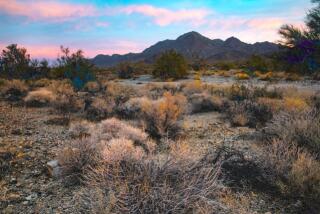Sacred Sites in Peril
- Share via
The Assn. on American Indian Affairs estimates that hundreds of sacred sites face destruction or desecration by land managers, commercial enterprises and tourists. Some recent controversies:
Medicine Wheel, Wyoming
The Medicine Wheel National Historic Landmark lies nearly 10,000 feet above sea level in the Bighorn National Forest in north-central Wyoming. The wheel, constructed of limestone rocks, is roughly 80 feet in diameter and has 28 spokes radiating from a center cairn. The wheel and surrounding lands are visited annually by more than 80 tribes from the United States and Canada for religious activities such as prayer offerings and vision quests. In 1996 the U.S. Forest Service created an 18,000-acre “area of consultation” in which activities that detract from the spiritual values of the landmark may be banned. In 1998 Wyoming Sawmills filed suit against the Forest Service, arguing that the policy violates the separation of church and state and restricts it from logging in the forest. A court ruling is pending.
Devils Tower, Wyoming
Devils Tower, an 867-foot butte in northeastern Wyoming, became the country’s first national monument in 1906. The tower is considered sacred to more than 20 Plains Indian tribes but is also acclaimed as one of the premier technical climbing areas in North America. In 1995 the National Park Service began asking rock climbers to voluntarily refrain from scaling the tower during the month of June, when Indians hold religious activities at the site. Several climbers filed suit, arguing that the provision violated separation of church and state. In March the U.S. Supreme Court allowed the voluntary closure to stand. The number of people climbing the tower in June has dropped an average of 85%.
Rainbow Bridge National Monument, Utah
The 275-foot-long sandstone arch, the world’s largest natural bridge, is located at the base of Navajo Mountain--just north of the Arizona state line and 259 miles south of Salt Lake City. The Natural Arch and Bridge Society this year sued the Park Service over a policy that asks visitors to voluntarily refrain from walking beneath or going too close to the bridge because of its religious significance to the Navajo and other tribes.
Mt. Graham, Arizona
Members of the San Carlos Apache tribe and environmentalists are fighting construction of a power line to a University of Arizona observatory on Mt. Graham, 120 miles northeast of Tucson. The 10,400-foot peak is a place of worship for the tribe.
Petroglyph National Monument, New Mexico
The 7,236-acre monument in Albuquerque was established in 1990 to protect more than 20,000 ancient rock etchings, largely done by Indians in volcanic rocks. Indians have opposed a proposed road through the monument to serve development on Albuquerque’s west side. Opponents say the road extension would harm land held sacred by New Mexico’s Sandia Pueblo and other tribes; proponents say the road is essential to ease congestion.
White Vulcan Pumice Mine, Arizona
Environmentalists and Indians are working to block a proposed expansion of the 100-acre White Vulcan pumice mine, on the flanks of the San Francisco Peaks near Flagstaff. The peaks, which contain Arizona’s highest point at 12,633 feet, are sacred to the Navajo Nation and other tribes. The tribes are supported by the Forest Service and Interior Department.
Glamis Imperial Project, California
The Bureau of Land Management is weighing plans by Glamis Imperial Corp. to develop an open-pit gold mine and processing facility among three mountains 45 miles northeast of El Centro. The Quechan tribe opposes the project on grounds that it would destroy cultural and religious sites. The mine would operate on 1,625 acres of BLM land, producing about 120 jobs and millions of tax dollars for Imperial County.
Badger-Two Medicine, Montana
The Forest Service has proposed a 20-year ban on hard-rock mining along the Rocky Mountain Front, where a decade-long moratorium on new oil and gas leases was imposed three years ago. The front, where the Rockies meet the plains in northwestern Montana, lies just south of Glacier National Park and includes the Badger-Two Medicine area--held sacred by the Blackfeet tribe. The Forest Service cited several reasons for the proposed ban, including the fact that Indians use the area to perform religious ceremonies, gather sacred herbs and practice other traditional customs.
More to Read
Sign up for Essential California
The most important California stories and recommendations in your inbox every morning.
You may occasionally receive promotional content from the Los Angeles Times.










